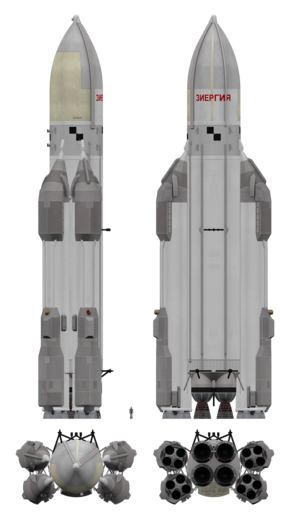
Back إنرجيا (صاروخ) Arabic Енергия (ракета) Bulgarian Enérguia Catalan Eněrgija Czech Energija German Energia (πύραυλος) Greek Energía (cohete) Spanish Energija (raketti) Finnish Energuia French एनेर्ग्य Hindi
 Energia perspective free render with multiple angles and human (1.76 m) for scale. | |
| Function | Human-rated multi-purpose super heavy-lift launch vehicle |
|---|---|
| Manufacturer | NPO "Energia" |
| Country of origin | Soviet Union |
| Cost per launch | US$764 million (1985)[1] |
| Size | |
| Height | 58.765 m (192.80 ft)[2] |
| Diameter | 17.65 m (57.9 ft)[2] |
| Mass | 2,400,000 kg (5,300,000 lb) |
| Stages | 2 |
| Capacity | |
| Payload to LEO | |
| Mass | 100,000 kg (220,000 lb)[3] |
| Payload to GSO | |
| Mass | 20,000 kg (44,000 lb)[3] |
| Payload to TLI | |
| Mass | 32,000 kg (71,000 lb)[3] |
| Launch history | |
| Status | Retired |
| Launch sites | Baikonur |
| Total launches | 2 |
| Success(es) | 2 |
| Failure(s) | 0 |
| First flight | 15 May 1987 |
| Last flight | 15 November 1988 |
| Boosters – Zenit | |
| No. boosters | 4 |
| Height | 39.46 m (129.5 ft)[2] |
| Diameter | 3.92 m (12.9 ft)[2] |
| Powered by | 1 RD-170 |
| Maximum thrust | 29,000 kN (6,500,000 lbf) sea level 32,000 kN (7,200,000 lbf) vacuum |
| Specific impulse | 309 s (3.03 km/s) at sea level 338 s (3.31 km/s) in vacuum |
| Burn time | 156 s |
| Propellant | RP-1/LOX |
| Core stage | |
| Height | 58.765 m (192.80 ft)[2] |
| Diameter | 7.75 m (25.4 ft)[2] |
| Powered by | 4 RD-0120 |
| Maximum thrust | 5,800 kN (1,300,000 lbf) sea level 7,500 kN (1,700,000 lbf) vacuum |
| Specific impulse | 359 s (3.52 km/s) at sea level 454 s (4.45 km/s) in vacuum |
| Burn time | 480–500 s |
| Propellant | LH2/LOX |
Energia (Russian: Энергия, romanized: Energiya, lit. 'Energy'; GRAU 11K25) was a 1980s super-heavy lift launch vehicle. It was designed by NPO Energia of the Soviet Union as part of the Buran program for a variety of payloads including the Buran spacecraft. Control system main developer enterprise was the Khartron NPO "Electropribor".[4][5] The Energia used four strap-on boosters each powered by a four-chamber RD-170 engine burning kerosene/LOX, and a central core stage with four single-chamber RD-0120 (11D122) engines fueled by liquid hydrogen/LOX.[6]
The launch vehicle had two functionally different operational variants: Energia-Polyus, the initial test configuration, in which the Polyus system was used as a final stage intended to put the payload into orbit, and Energia-Buran,[7] in which the Buran orbiter was the payload and the source of the orbit insertion impulse.
The launch vehicle had the capacity to place about 100 tonnes in Low Earth orbit, up to 20 tonnes to geostationary orbit and up to 32 tonnes by translunar trajectory into lunar orbit.[3]
The launch vehicle made just two flights before being discontinued.[8][7] Since 2016, there have been attempts to revive the launch vehicle, reusing an updated version of its booster engine in the Soyuz-5 rocket.
- ^ Wade, Mark. "Energia". Encyclopedia Astronautica. Retrieved January 16, 2025.
- ^ a b c d e f Energia Characteristics
- ^ a b c d Launch vehicle "Energia" Official Site
- ^ Krivonosov, Khartron: Computers for rocket guidance systems
- ^ Control systems for intercontinental ballistic missiles and launch vehicles Archived 2010-02-05 at the Wayback Machine
- ^ Russian Space Web, Energia page. Accessed 21 September 2010
- ^ a b Bart Hendrickx; Bert Vis (2007). Energiya-Buran: The Soviet Space Shuttle. Springer Science & Business Media. ISBN 978-0-387-73984-7.
- ^ Cite error: The named reference
JBIS-2002was invoked but never defined (see the help page).